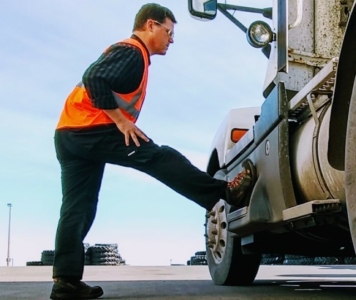There are several injury exposures that auto mechanics and technicians experience during their normal day to day operation. According to the most current Bureau of Labor Statistics injury and illness report auto mechanics and technicians had 13,150 nonfatal occupational injuries and illnesses, as the workers are exposed to dangerous machinery, tools, chemicals, and a strenuous work environment. The negative effects stretch beyond the injured employee, as the employer could accrue higher wage replacement, medical costs, repairs to damaged equipment, and increased workers compensation insurance premiums. Business owners can help keep employees safe by understanding the common causes of auto shop accidents, providing regular training and requiring all staff to follow important safety procedures.
Here are the 5 most common types of injuries sustained in the industry and solutions.
1) Strains, Sprains, Tears
This is the leading cause of injury for auto mechanics and technicians in the workplace. Overexertion injuries are related to pulling, lifting, pushing, holding, carrying and throwing. The causes of stress type injuries can be caused by improper lifting, manually lifting heavy objects, no breaks, and repetitive tasks. Safe work practices that can be implemented to help mitigate these type of strain type exposures include:
Solution:
- Implementing a 10 minute “stretch and flex” program before the workday begins. This will help loosen up muscles and better prepare the body to handle the physical demand of the day.
- Remember to lift with your knees and not your back, and to keep the load close to your body.
- Provide your employees mechanical lifting equipment, especially when the load is 50 pounds or more, such as a dolly or a forklift.
- Implement shorts breaks throughout the day to give the employees body a break and stretch if needed.
- Changing up the employees work to reduce their exposure to a certain repetitive tasks can also help.
2) Eye Injuries
Auto mechanics and technicians work under hoods and vehicles, with hazardous chemicals, and dangerous equipment. Whether it’s working underneath a car and being exposed to rust particles and other debris, or welding and being exposed to sparks, or using a grinder and being exposed to flying particles, there are many facets of the job that can lead to an eye injury.
Solution:
- The best prevention against eye injuries is to implement a mandatory safety glass policy. Also, it is helpful to get your employees feedback on models of glasses that best suite them, so they are more apt to wear them in any work condition. For instance, fog resistant glasses, prescription glasses if needed, and overall comfort.
3) Chemical Burns
Located within auto garages there are all types of hazardous chemicals that a mechanic / technician can be exposed to. The chemical exposure can cause serious injury in the form of skin irritation, chemical burns, fire, poisoning, etc.
Solution:
- Have a hazardous communication program in place which consists of an up to date list of Safety Data Sheets for all chemicals used at your business.
- All employees should be trained on how to read the SDS sheets so they can take appropriate action if exposure to a chemical occurs.
- All chemicals should be labeled, which consists of name, address and telephone number, product identifier, signal word, hazard statement(s), precautionary statement(s), pictogram(s).
4) Loss of Limb or Digit
Mechanics and technicians use power tools and equipment, such as grinders and electric metal shears, etc., which presents the danger of loss of limb or digit. The following practices can help prevent these types of injures.
Solution:
- Train employees to follow proper equipment operating procedures.
- Keep all protective guards in place.
- Wear all essential PPE while using the particular tool / equipment.
- Routinely inspect power tools to ensure they are in proper working condition with no defects.
5) Slips, Trips, Falls
The auto garage presents several exposures which can lead to slips, trips, and falls. Oil changes, transmission flushes and other routine vehicle maintenance procedures that involve slippery or greasy fluids can make the shop floor slick, increasing the risk of accidents. Also, the presence of hoses and electrical cords running through the shop and storage in walking paths can present trip hazards as well.
Solution:
- Ensure the housekeeping is kept in order and there is no storage or debris in walking paths.
- Ensure walking paths themselves are in good condition with no defects.
- All spills should be cleaned up immediately and have appropriate warning signs posted if applicable.
- Have employees wear anti-skid footwear to allow for better traction while in the workspace. Especially in the wintertime when dealing with ice and snow.
- Hoses should be coiled up if not in use or have hose reels installed to keep hoses from lying on the ground.
- Electrical cords should be rolled up if not in use. If cords run through walking paths then plastic “drop over cable protectors” should be used so employees can walk over the cords in a safe manner.
Contact us today to learn more about how since 1995, our member businesses have saved millions of dollars!
Recent Posts
The U.S. Department of Labor Announces Proposed Rule To Protect Indoor, Outdoor Workers From Extreme Heat
The U.S. Department of Labor has proposed a new rule aimed at protecting workers from extreme heat hazards. This initiative seeks to safeguard approximately 36 [...]
Supreme Court Overturns Chevron Deference: What It Means for Workplace Safety and Regulation
The landscape of federal regulation is set for a seismic shift following a recent Supreme Court decision. On June 28, in Loper Bright Enterprises, et [...]
Navigating the Compliance Maze: How NARFA Simplifies Employee Benefits for Automotive and Trade Industries
In today's complex regulatory environment, businesses in the automotive, roads, fuel, and related industries face unprecedented challenges in managing employee benefits. Recent studies show that [...]




